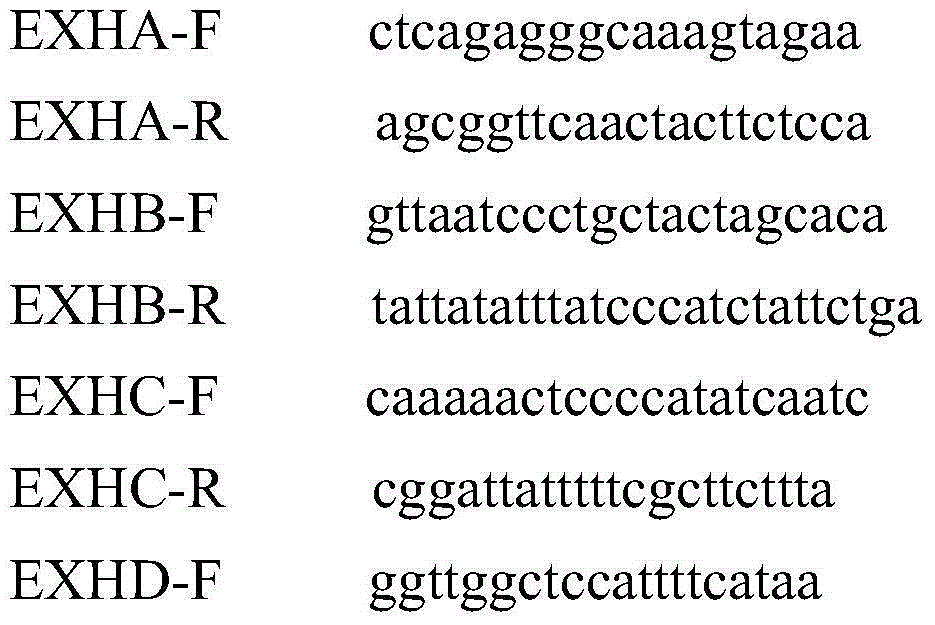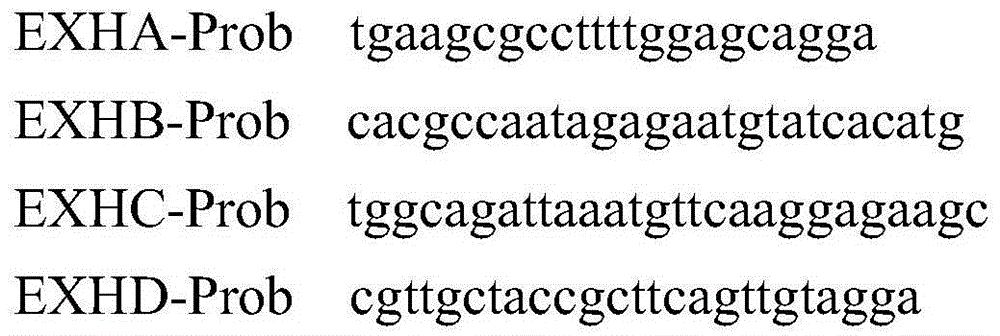Multiple-fluorescence PCR detection method and kit for S.hyicus exfoliative toxin types
A technology for Staphylococcus suis and detection kits, which is applied in the direction of microorganism-based methods, biochemical equipment and methods, and microorganism measurement/testing, and can solve the problems of little guiding significance, long time-consuming, poor sensitivity and specificity And other problems, to achieve the effect of high sensitivity, saving consumables, and low cost
- Summary
- Abstract
- Description
- Claims
- Application Information
AI Technical Summary
Problems solved by technology
Method used
Image
Examples
Embodiment 1
[0037] Embodiment 1: the specificity test of primer, probe
[0038] Using bioinformatics and biological software for designing primers and probes, the sequences of the four exfoliation toxins EXHA, EXHB, EXHC and EXHD genes of Staphylococcus suis in the existing database (GenBank numbers in NCBI are: JQ728534, EU259000, JQ728530, AF515456) After the comparative analysis, the primers and probes shown in Table 1 were designed to realize multiple fluorescent PCR detection of Staphylococcus suis shedding toxins EXHA, EXHB, EXHC and EXHD. Table 1 is the sequence of primers and probes of Staphylococcus suis exfoliated toxin.
[0039] Table 1 Sequences of primers and probes for the shedding toxin of Staphylococcus suis
[0040]
[0041]
[0042] The fluorescent probe information after the probe sequence is fluorescently labeled is shown in Table 2
[0043] Table 2
[0044] EXHA
EXHA-Prob-FAM
FAM-tgaagcgccttttggagcagga-BHQ
EXHB
EXHB-Prob-JOE
JOE-...
Embodiment 2
[0049] Embodiment 2: the specificity test of multiple fluorescent PCR detection reagent
[0050] Multiple detection reagents were prepared using the PCR buffer in the Premix Ex Taq kit of TaKaRa Company, wherein the amount of each primer added in Table 1 was 5-15 pmol, and the amount of various probes added in Table 1 was 2 -10pmol, 10μL of Premix solution (including TaKaRa Ex Taq0.5U, dNTPs and Ex Taq Buffer), add water to a total volume of 20μL, in which the volume of the DNA solution extracted from the detection sample is 2μL, and finally placed in a fluorescent quantitative PCR instrument for reaction, reaction conditions As follows: 95°C for 30 seconds, thermal cycle of 95°C for 1 second, 60°C for 20 seconds, a total of 40 cycles.
[0051] Single-positive templates (cultures of strains HZ-2, ExhB1-2007, ZC-2, and GZ-3, which produce shedding toxins EXHA, EXHB, EXHC, and EXHD, respectively) and quadruple-positive templates were used, respectively. (for an equal mix of cul...
Embodiment 3
[0056] Example 3: Sensitivity test of multiple fluorescent PCR detection reagents for Staphylococcus suis exfoliated toxin
[0057] In order to further test the sensitivity of the reagent, a 10-fold gradient dilution was carried out on the positive sample of Staphylococcus suis exfoliated toxin. 6 times, and then compared with multiplex and singlex PCR detection of Staphylococcus suis shedding toxin, the results are shown in Table 4. Table 4 is a data table of comparative experimental results of multiplex and singlex PCR detection reagents on 10-fold serially diluted positive samples.
[0058] Table 4
[0059]
[0060]
PUM
 Login to View More
Login to View More Abstract
Description
Claims
Application Information
 Login to View More
Login to View More - R&D
- Intellectual Property
- Life Sciences
- Materials
- Tech Scout
- Unparalleled Data Quality
- Higher Quality Content
- 60% Fewer Hallucinations
Browse by: Latest US Patents, China's latest patents, Technical Efficacy Thesaurus, Application Domain, Technology Topic, Popular Technical Reports.
© 2025 PatSnap. All rights reserved.Legal|Privacy policy|Modern Slavery Act Transparency Statement|Sitemap|About US| Contact US: help@patsnap.com



